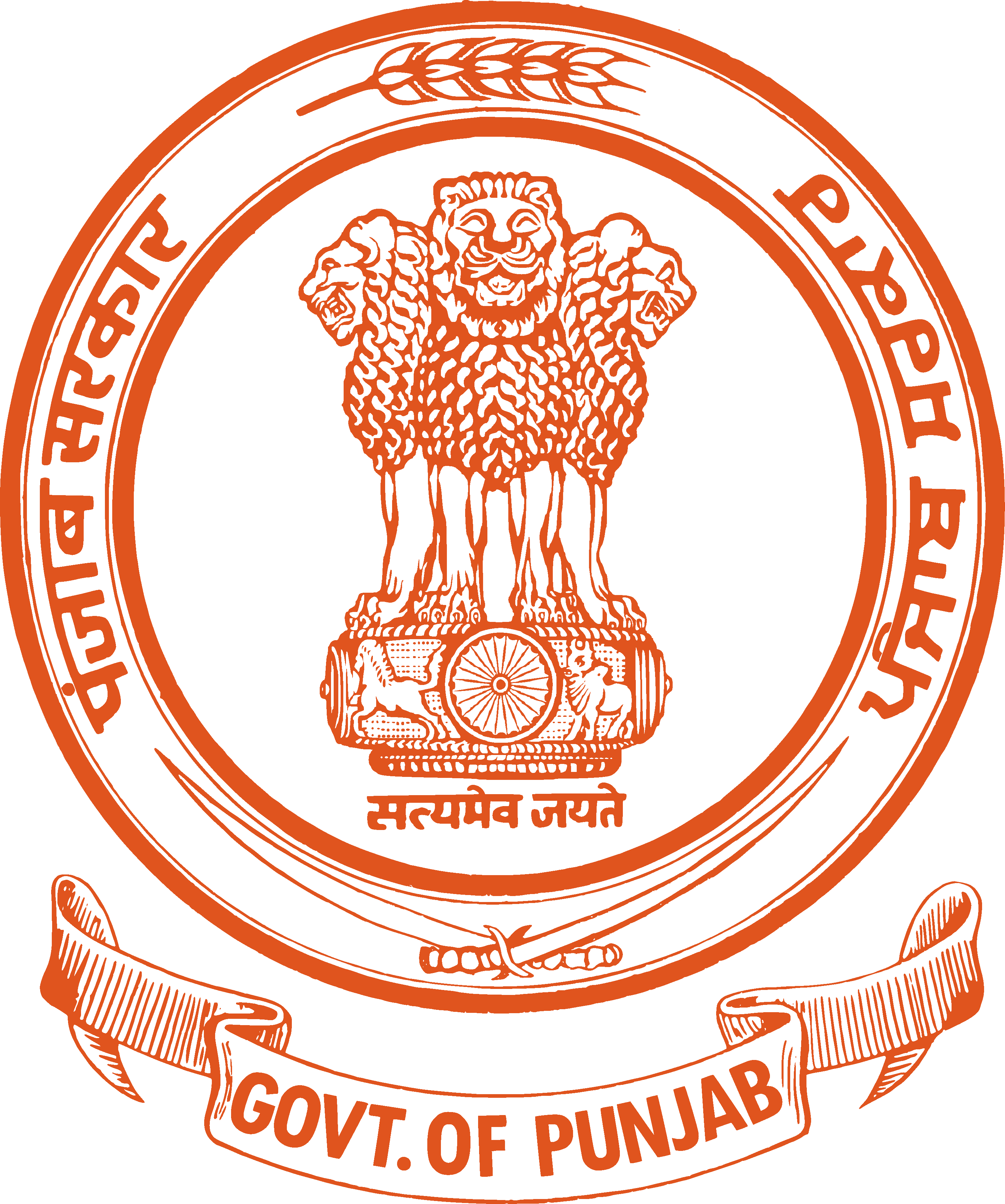
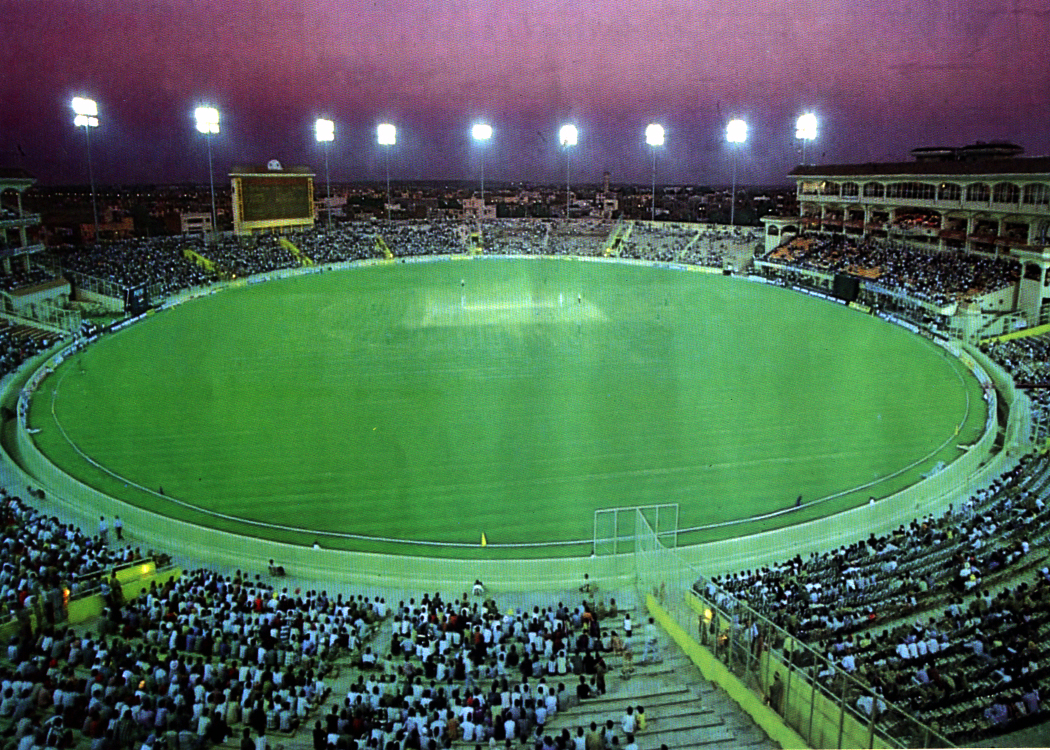

 Punjabis play a wide variety of sports and games, ranging from modern games such as
Punjabis play a wide variety of sports and games, ranging from modern games such as Cricket
 Cricket is a favourite sport of Punjabis. The sport is governed at State level by the Punjab Cricket Association. The
Cricket is a favourite sport of Punjabis. The sport is governed at State level by the Punjab Cricket Association. The Gatka
Gatka ( pa, ਗਤਕਾ) is a traditional South Asian form of combat-training in which wooden sticks are used to simulate swords in sparring matches.Kabaddi
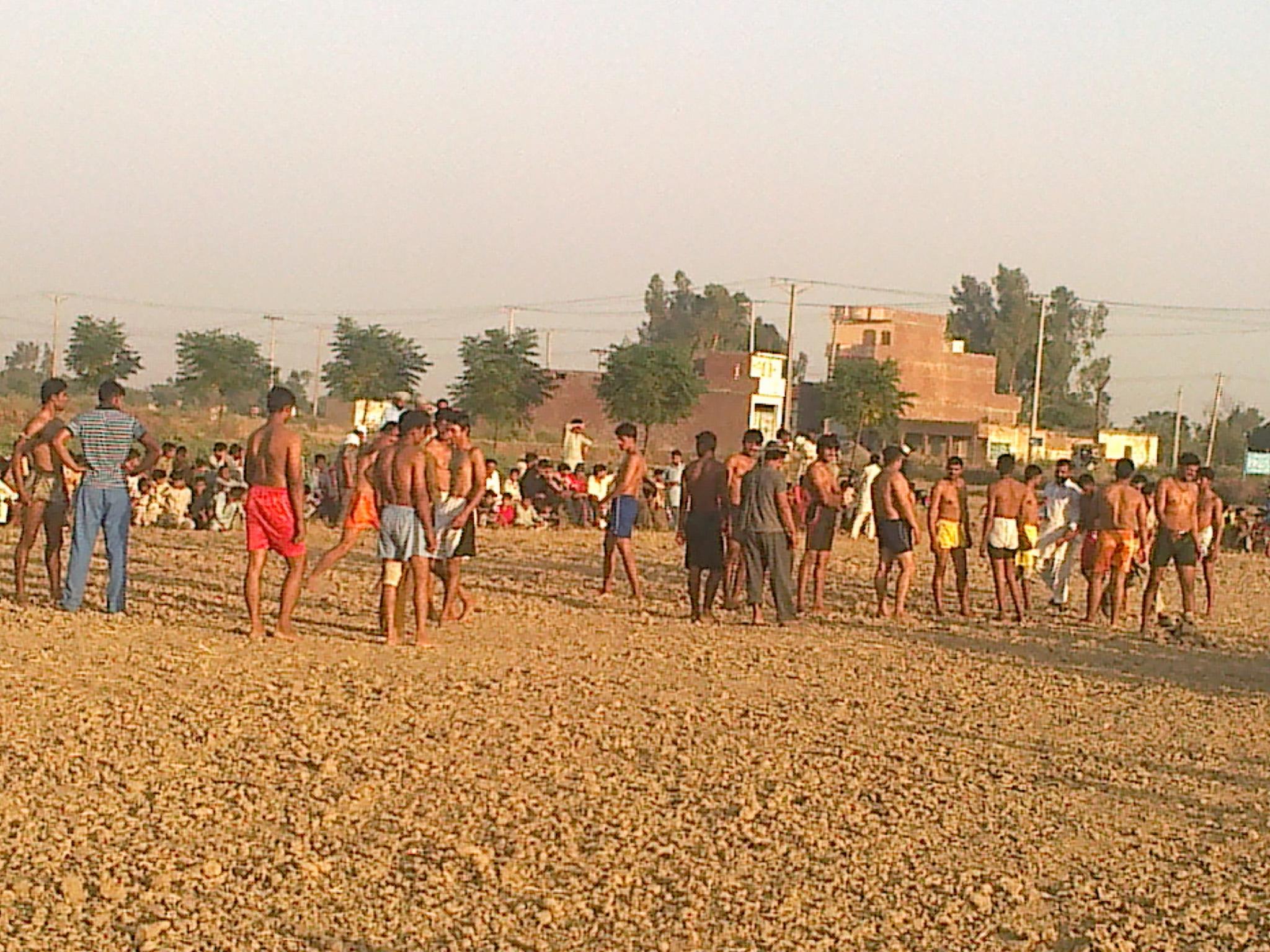

Punjab Circle style
This is the state game of Punjab.Kabaddi World Cup
Punjab has been coordinating the Kabaddi World cup since 2010 which is based on the Punjab Circle style. The Men's final in the World cup of 2014 was played between India and Pakistan and was won by India 45–42. The Women's final was between India and New Zealand with India winning 36–27 for the second time in a row. The closing ceremony was held at the Guru Gobind Singh Stadium, BadalWorld Kabaddi League
World Kabaddi League was introduced in 2014. The league followed the rules & guidelines as defined by the Punjab circle style Kabaddi. The league was played across four countries from August 2014 to December 2014.Traditional Punjabi Kabaddi styles
Lambi Kauddi
In Lambi Kauddi ( pa, ਲੰਬੀ ਕੌਡੀ) there are 15 players with a cicular pitch of 15–20 feet. There is no outer limit. The players can run as far they can. There is no referee. The raider will say "kauddi, kauddi" throughout the attack.Saunchi Kauddi
Saunchi Kauddi ( pa, ਸੌਚੀ ਕੌਡੀ)Punjab Diyan Virasiti Kheda by Suhdev Maudhupuri. Chetna Parkashan (also called Saunchi pakki/ pa, ਸੌਚੀ ਪੱਕੀ) can best be described as being similar to boxing. It is popular in the Malwa area of Punjab. It is unlimited players with a cicular playing pitch. A bamboo with a red cloth is dug into the ground which is paraded by the winner. In sauchi kabaddi, the raider will hit the defender but only on the chest. The defender will then hold the raiders wrist. A foul is declared if any other part of the body is grabbed. If the defender hold the raiders wrist and restricts his movement, he will be declared the winner. If the raider loses the grip of the defender, then the raider will be the winner.Goongi Kabaddi
A popular style is "Goongi Kabaddi" ( pa, ਗੂੰਗੀ ਕਬੱਡੀ) (silent Kabaddi) where a raider player does not speak and say the word kabaddi but just touches the opponent's team player and the whom he touches only that player will try to stop the player. The struggle will continue till he reaches the starting line or acknowledge the defeat and loses a point, or if he safely reaches the starting line, he will get the point.Hockey
Football
Punjab Football Association (PFA) is the state governing body ofBasketball
Punjab has traditionally been home to several of India's top basketball players who have represented the country's national basketball team. In 2016, the Punjab Steelers were runners-up of theTraditional Punjabi Sports and Games
There are a wide variety of traditional games played by children and adults. With the spread of games such as hockey and cricket, some of the traditional Punjabi games are not played as much as they once were. However, the current repertoire of traditional Punjabi games is wide and this article gives an outline of some of the games. In order to play a game, it is necessary to select the captain who is known as a dayee, meetee, or pit. There are various ways of selecting players. One method used by children to select the captain is by all the players standing in a circle, with one player going around the circle singing:''Engan mengan''Punjabi:
''Tali talengan''
''Kalaa peelaa dakra''
''Gurh kahava bail vadhava''
''Moollee patra''
''Patra valey ghorhay aya''
''Hath kutarhee per kutarhee''
''Nikal balya teri vari''
''ਏਂਗਣ ਮੇਂਗਣ''The player saying the above will stop at the player when the song finishes who then is selected. The last player becomes the captain.
''ਤਲੀ ਤਲੇਂਗਣ''
''ਕਾਲਾ ਪੀਲਾ ਡੱਕਰਾ''
''ਗੂੜ ਖਾਵਾਂਂ ਵੇਲ ਵਧਾਵਾਂ''
''ਮੂਲੀ ਪੱਤਰਾ''
''ਪੱਤਰਾਂ ਵਾਲੇ ਘੋੜੇ ਆਏ''
''ਹੱਥ ਕੁਤਾੜੀ ਪੈਰ ਕੁਤਾੜੀ''
''ਨਿਕਲ ਬਾਲਿਆ ਤੇਰੀ ਵਾਰੀ''
Male sports and games
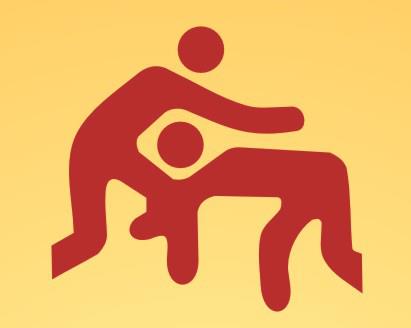
Kushtian ( pa, ਕੁਸ਼ਤੀਆ)
The wrestling will take place in a circular court with soft ground which in Punjabi is called an " akharha". Two wrestlers will continue to wrestle until the back of one touches the ground. The winner will parade the court with the loser following him. The wrestlers are called Pehlwans who train with modern weights and traditional weights such as aKhuddo khoondi ( pa, ਖਿੱਦੋ ਖੂੰਡੀ)
 Similar to field hockey, the game involves using a ball made of rags and a stick with a natural curve at one end. The stick would normally be a tree branch.
Similar to field hockey, the game involves using a ball made of rags and a stick with a natural curve at one end. The stick would normally be a tree branch.
Rassakashi ( pa, ਰੱਸਾਕਸ਼ੀ)
Dand parhangrha ( pa, ਡੰਡ ਪੜਾਂਗੜਾ)
A group of boys gather around a tree. A circle with a diameter of 2 1/2 feet is drawn. A short stick is placed in the circle. One boy is selected to pick the stick and throw it as far possible, by swinging it under his leg. Another boy is selected to collect the stick during which time all the boys run up the tree. The boy who has collected the stick places it in the circle. The other boys try to get the stick before being caught by the boy who placed it there. If the boy who placed the stick tags another player before anyone picks up the stick, the boy who has been tagged is the one who has to stay on the ground and try to tag another player. If a player picks up the stick before the original player on the ground who collected the stick tags another, the game ends and a new game start but the original player has to tag another player.Bandar keela ( pa, ਬਾਂਦਰ ਕੀਲਾ)
This Game Start was Since 1902 5 October Boys play this game in winter by digging a pole into the ground and attaching a four-foot rope. All the boys place their shoes near the pole. The boy who is holding the rope (the key player) is meant to stop the other boys from getting their shoes. During the game, if the key player touches another player then that player becomes the key player(bandar) and the game goes on ....Tibla tiblee ( pa, ਟਿਬਾ ਟਿਬਲੀ)
This is a boys and a teenagers game. The boys will form two teams. Team one will ask team two, "which house in the village has 3 (x) and 4(y)?" If the other team guess, they win but if not, the losing team will have to carry the winning boys on their backs to the house in question.Rabb di Khuti ( pa, ਰਬ ਦੀ ਖੁਤੀ)
 The game is played by as many players wish to play who will select the key player (dyee). The players will use a soft ground and dig holes about 9" wide and 6" deep. Each hole is called a khuti. There will be as many holes as there are players. In the middle of the playing ground, a larger hole will be dug out and is referred to as rabb di khuti (God's hole).
The key player will throw a ball made of rags high into the air. The player that catches it will then be carried by the key player to enable key player to kick the ball into the hole. If he does, the two players switch and the key player will be carried enabling the other player to kick the ball. If the player kicks the ball into another player's hole, then the two will switch sides. This is repeated for all the players. If the ball lands in the rabb di khuti, the player who threw the ball will try to tag another player with the ball. All the other players try to avoid being hit.
The game is played by as many players wish to play who will select the key player (dyee). The players will use a soft ground and dig holes about 9" wide and 6" deep. Each hole is called a khuti. There will be as many holes as there are players. In the middle of the playing ground, a larger hole will be dug out and is referred to as rabb di khuti (God's hole).
The key player will throw a ball made of rags high into the air. The player that catches it will then be carried by the key player to enable key player to kick the ball into the hole. If he does, the two players switch and the key player will be carried enabling the other player to kick the ball. If the player kicks the ball into another player's hole, then the two will switch sides. This is repeated for all the players. If the ball lands in the rabb di khuti, the player who threw the ball will try to tag another player with the ball. All the other players try to avoid being hit.
Noon miani ( pa, ਨੂਣ ਮਿਆਣੀ)
 The game is played on a grid on the ground with an approximate measurement of 25 meters in each side. 4 boxes of equal size are drawn in the grid leaving a 2-meter track on the outskirts. In the center of the grid, a fifth square is drawn filled with a heap of sand or soil (mitti di dheri ( pa, ਮਿਟੀ ਦੀ ਢੇਰੀ)) which represents salt. Outside the grid, another box is drawn on the northern edge, in the center which represents the store called sandook ( pa, ਸੰਦੂਕ).
The key player is selected to mind the salt in the center square. The other players try to get the salt and run along the pathways to go to the other side of the store. The key player's aim is to tag the other players.
To start the game, one player will touch the key player's hand and then run away to avoid being tagged. If the other players step into the 4 boxes in the grid, they will be killed and declared "madeen" ( pa, ਮਦੀਨ). The key player cannot go backwards on the track, until he reaches the end of the box, whilst remaining on the track. He cannot step into any box in the grid.
Players who take the salt and run across the store area are declared "nar" ( pa, ਨਰ.) The players who get tagged become "madeen". The key player will become "nar" after tagging another player. Otherwise, he will be "madeen". Once all players become either"nar" or "madeen", the game ends.
At this point, the players who have crossed the store area and have become "nar" will stand in a line. About 25 metres away, the "madeen" group will stand in a line. The "nar" players will ask the "madeen" players: "bil bachya di maa, roti pakki ai ki na?" (translation: bill's mother, are the chapattis made?) ( pa, ਬਿਲ ਬਚਿਆ ਦੀ ਮਾਂਂ. ਰੋਟੀ ਪਕੀ ਏ ਕਿ ਨਾ?). If the "madeen" group say no, the "nar" group will ask the question again until the "madeen" group say, yes. At this point, all the players run to tag each other. The "madeen" players who get tagged by the "nar" players, will need to carry them to the centre square. The game then starts again but this time, the key player will be the player who became "madeen" first.
The game is played on a grid on the ground with an approximate measurement of 25 meters in each side. 4 boxes of equal size are drawn in the grid leaving a 2-meter track on the outskirts. In the center of the grid, a fifth square is drawn filled with a heap of sand or soil (mitti di dheri ( pa, ਮਿਟੀ ਦੀ ਢੇਰੀ)) which represents salt. Outside the grid, another box is drawn on the northern edge, in the center which represents the store called sandook ( pa, ਸੰਦੂਕ).
The key player is selected to mind the salt in the center square. The other players try to get the salt and run along the pathways to go to the other side of the store. The key player's aim is to tag the other players.
To start the game, one player will touch the key player's hand and then run away to avoid being tagged. If the other players step into the 4 boxes in the grid, they will be killed and declared "madeen" ( pa, ਮਦੀਨ). The key player cannot go backwards on the track, until he reaches the end of the box, whilst remaining on the track. He cannot step into any box in the grid.
Players who take the salt and run across the store area are declared "nar" ( pa, ਨਰ.) The players who get tagged become "madeen". The key player will become "nar" after tagging another player. Otherwise, he will be "madeen". Once all players become either"nar" or "madeen", the game ends.
At this point, the players who have crossed the store area and have become "nar" will stand in a line. About 25 metres away, the "madeen" group will stand in a line. The "nar" players will ask the "madeen" players: "bil bachya di maa, roti pakki ai ki na?" (translation: bill's mother, are the chapattis made?) ( pa, ਬਿਲ ਬਚਿਆ ਦੀ ਮਾਂਂ. ਰੋਟੀ ਪਕੀ ਏ ਕਿ ਨਾ?). If the "madeen" group say no, the "nar" group will ask the question again until the "madeen" group say, yes. At this point, all the players run to tag each other. The "madeen" players who get tagged by the "nar" players, will need to carry them to the centre square. The game then starts again but this time, the key player will be the player who became "madeen" first.
Tipri
Tipri is a dance cum team sport played on the festive occasion of Vamana Dwadashi on the streets, predominantly in the current city ofFemale sports and games
Thaal ( pa, ਥਾਲ)
This is played by a group of girls using a ball made of seven layers of cloth. The ball is bounced in one hand with the girl singing rhymes. The girl who sings the longest is the winner.Kikli ( pa, ਕਿੱਕਲੀ)

''Kikli kleer di''Punjabi:
''Pag mere vir dee''
''Daupatta mere bhai da''
''Phitte mun jawai da''
''ਕਿਕਲੀ ਕਲੀਰ ਦੀ''
''ਪੱਗ ਮੇਰੇ ਵੀਰ ਦੀ''
''ਦੁਪੱਟਾ ਮੇਰੇ ਭਾੲੀ ਦਾ''
''ਫਿਟੇ ਮੂੰਹ ਜੁਵਾੲੀ ਦਾ''
Adhi chharhapa ( pa, ਅੱਡੀ ਛੜੱਪਾ)
This is played by two teams of girls with around 6 players in each team. Two girls from team 1 will sit on the floor with their legs straight and their feet touching. A girl from team 2 will jump over the legs of the girls of team 1, without touching them. If she succeeds, two more girls from team 1 will join her team players on the floor thereby widening the area for the next player of team 1 to jump over. This carries on until all the girls from team 1 have jumped over the girls if team 2, after which the players of team 1 will sit on the floor.Gheeta Pathar ( pa, ਗੀਟਾ ਪੱਥਰ)
Some pebbles, stones or broken earthenware can be broken further into pieces and used for playing Gheeta Pather. The players will draw a circle on the floor and throw 5 pieces into the circle. The aim of the game is to throw each stone into the air and catch it before it falls without touching the other stones. The player must collect all the stones in one hand.Peecho bakree ( pa, ਪੀਚੋ ਬਕਰੀ)

 Similar to hopscotch. It is also called adda khadda. The game involves drawing 8 or 10 boxes on the ground. Starting on the right, the boxes will be numbered going across with box 5 on the right having a diagonal line.
The player will throw the stone on box 1 and hop onto box 1. Whilst hopping, using the other leg, the player will kick the stone across to box 2 and then hop to that box. The aim is to hop to each box whilst ensuring the stone does not go out of the intended box. When the player gets to box 5, she will need to put both feet in each section of the box and then continue to the other boxes.
Similar to hopscotch. It is also called adda khadda. The game involves drawing 8 or 10 boxes on the ground. Starting on the right, the boxes will be numbered going across with box 5 on the right having a diagonal line.
The player will throw the stone on box 1 and hop onto box 1. Whilst hopping, using the other leg, the player will kick the stone across to box 2 and then hop to that box. The aim is to hop to each box whilst ensuring the stone does not go out of the intended box. When the player gets to box 5, she will need to put both feet in each section of the box and then continue to the other boxes.
Hara samundar ( pa, ਹਰਾ ਸਮੁੰਦਰ)
A group of girls stand in a circle and link arms. One girl stand in the middle. The area in the circle is meant to be the sea. The girls forming the ring ask the girl in the middle, how deep is the water in sequence. She would reply, ankle deep and then say knee deep, waist deep, neck deep and finally "I am drowning" at which point she would fall to the ground. The other girls would break the chain and save her. The game is repeated with another girl in the middle.Khidu ( pa, ਖਿਡੂ)
The girls sing rhymes along with a Khidu (Ball), in fact these rhymes and the game is more suitable for children. The rounds continue until the end by counting ten and singing the tenth song.Pangurha ( pa, ਪੰਘੂੜਾ)
Pangurha is a game played by small girls. Normally, the game involves 8 players with 4 players sitting on the floor with their legs stretched out touching each other's’ feet. The 4 standing players will hold the hands of the players on the floor and swing the arms left and then right in slow motion. The movements gradually become faster giving the seated girls the feeling they are on a fairground ride. The standing players will then take the place of the seated players and the game continues.Games for boys and girls


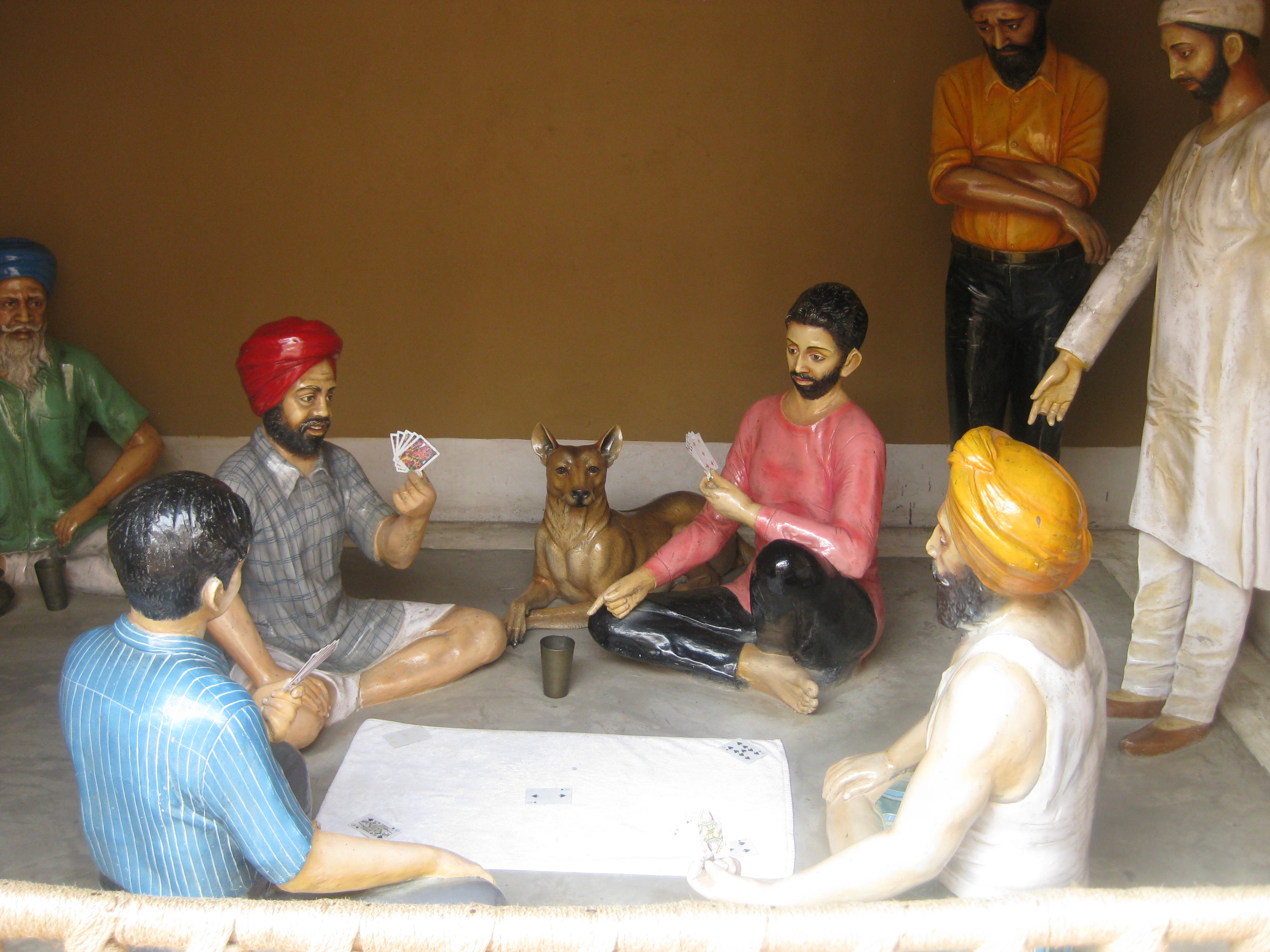
Lattoo ( pa, ਲਾਟੂ) (yo-yo)
Played mostly by boys.Bantey ( pa, ਬੰrਟੇ)
Marble games.Chicho Chich Ganerian ( pa, ਚੀਚੋ ਚੀਚ ਗਨੇਰੀਆਂ)
This game is for both boys and girls. It is generally played by two teams and involves drawing as many vertical lines as possible.Kidi Kada or Stapoo ( pa, ਸਟਾਪੋ)
This is a game played both by the girls and boys. This game is played with in small boundary (court), drawn on the ground and a piece of stone.
Lukan Miti ( pa, ਲੁਕਣ ਮੀਟੀ) (hide and seek)
This is also played by both boys and girls and continues to this day. Two teams can also play this. One has to hide, the other has to seek but before doing so a call is given.Kokla Chhapaki ( pa, ਕੋਕਲਾ ਛਪਾਕੀ)
This game is popular even today amongst children. Both boys and girls play it. Children sit in a circle and the child who has the cloth in his hand goes around the circle-singing: it is a kind of a warning for the children sitting in a circle not to look back. The cloth is then dropped at the back of a child. If it is discovered before the child who had placed it there had completed the round, the child who discovered the cloth would run after him and try to touch him with it till he sits in the place vacated by the one who had discovered the cloth. The song sung during the game is:''Kokla Chapaki Jumeraat aayi aye''Meaning:.
''jera agge pichey wekhey''
''ohdi shamat aayi aye''
''Kokla Chapaki, it is Thursday.''Punjabi:
''Whoever looks here and there''
''shall be punished.''
''ਕੋਕਲਾ ਛਪਾਕੀ ਜੁਮੇ ਰਾਤ ਆਈ ਏ''
''ਜੇਹੜਾ ਅਗੇ ਪਿਛੇ ਦੇਖੇ''
''ਉਹਦੀ ਸ਼ਾਮਤ ਆਈ ਏ''
Alye Patalye ( pa, ਅੱਲੀਏ ਪਟੱਲੀਏ)
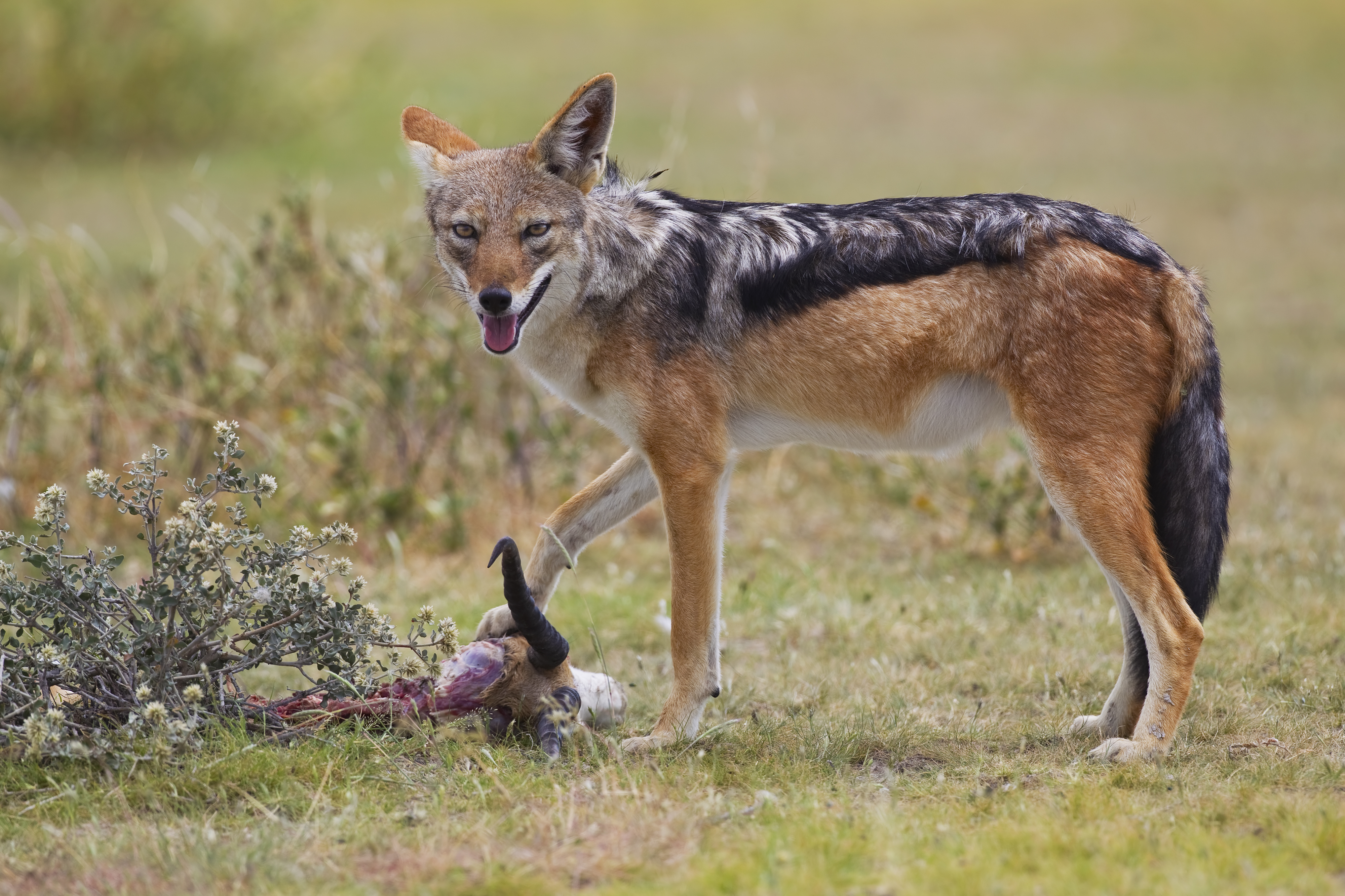
 The game is played by two groups of children. One group pretend to be jackals (Gidharh, ( pa, ਗਿੱਦੜ)) and the other, pickers (chogian, ( pa, ਚੋਗੀਆ)). There is a line drawn between the two groups. The pickers sing the following song which calls for their members to pick the fields but then warns the group that there are jackals ahead.
Punjabi:
The game is played by two groups of children. One group pretend to be jackals (Gidharh, ( pa, ਗਿੱਦੜ)) and the other, pickers (chogian, ( pa, ਚੋਗੀਆ)). There is a line drawn between the two groups. The pickers sing the following song which calls for their members to pick the fields but then warns the group that there are jackals ahead.
Punjabi:
''ਅੱਲੀਏ ਪਟੱਲੀਏ''
''ਕਪਾਹ ਚੁਗਣ ਚੱਲੀਏ ''
''ਮੂਹਰੇ ਬੈਠੇ ਗਿੱਦੜ''
''ਪਿਛਾਂਹ ਮੁੜ ਚੱਲੀਏ''
''alye patalye''The chogyan team will jump over line and bend from the waist and pretend to pick the cotton flowers from the fields. The jackals will chase the other team. If a jackal tags the other team player, that player will join the jackal team. Once all players join the jackal team, the game starts all over again.
''kapah chugan chalye ''
''moohre bether gidharh''
''pichhah murh chalye''
Bhanda bhandarya ( pa, ਭੰਡਾ ਭੰਡਾਰੀਆ)
This game is played by a group of about 15 children. The key player sits on the floor and the rest form a circle around him and place their fists on top of each other's fists. Then the children ask the key player: Punjabi:''ਭੰਡਾ ਭੰਡਾਰੀਆ''
''ਕਿੰਨਾ ਕੁ ਭਾਰ ''
''bhanda bhandarya''Translation:
''kinna ku bhar''
''bhanda bhandarya''The key player's response will be: Punjabi:
''what is the weight''
''ੲਿਕ ਮੱਠੀ ਚੁੱਕ ਲੈ''
''ਦੂੲੀ ਤਿਆਰ''
''ik muthi chuk lai''Translation:
''dui tyar''
''lift one fist''As soon as the last player lifts his fists, all the children will run away singing: Punjabi:
''the other is ready''
''ਹਾੲੇ ਕੁੜੇ ਦੰਦੲੀਆ ਲੜ ਗਿਆ''
''ਬੂੲੀ ਕੁੜੇ ਦੰਦੲੀਆ ਲੜ ਗਿਆ''
''hay kurhe dandayaa larh gya''Translation:
''bui kurhe dandayaa larh gya''
''I have been bitten''The key player will then chase the other players to tag another player to start the game all over again.
''I have been bitten''
Kooka kanghrhey ( pa, ਕੂਕਾਂ ਕਾਂਘੜੇ)
Kooka kanghrhey involves a two groups of children: one group is called the owners the other is called servants. There is no limit to the number of players or their age. The game is played by dividing the village lane into two halves for use by each group. Each group will draw as many lines on the hidden parts of the houses as possible. The aim is to prevent the opponent's team from finding the lines.Part 1
Both teams gather at the centre part of the lane. One player of either team will say "kooka kanghrey" ( pa, ਕੂਕਾਂ ਕਾਂਘੜੇ)or "patt patteellay" ( pa, ਪਟ ਪਟੀਲੋ). At this point the two groups will start to draw the lines. The group that finishes drawing the lines first will send a player to the centre of the lane to shout "kooka kanghrey" or "patt pattellay". At this point all the players stop drawing lines.Part 2
The two groups will go to the opponent team's part of the lane. The aim is to find the lines drawn by the other team and then strike lines through those lines. After this is done, the team assembles at the starting place.Part 3
The two groups will count how many of their lines have been struck through and how many have been left unmarked. The winning team will be the one with the larger number of unmarked lines.Pithoo ( pa, ਪਿੱਠੂ)
General

Kite Flying (Patang Bazi)
Flying kites is especially popular in festivals such as Basant andRaces
Camel and bullockcart races, cock fights in addition to Kabutar bazi, chakore bazi and bater bazi.Board games
Chauparh OR Pasha ( pa, ਚੌਪੜ)

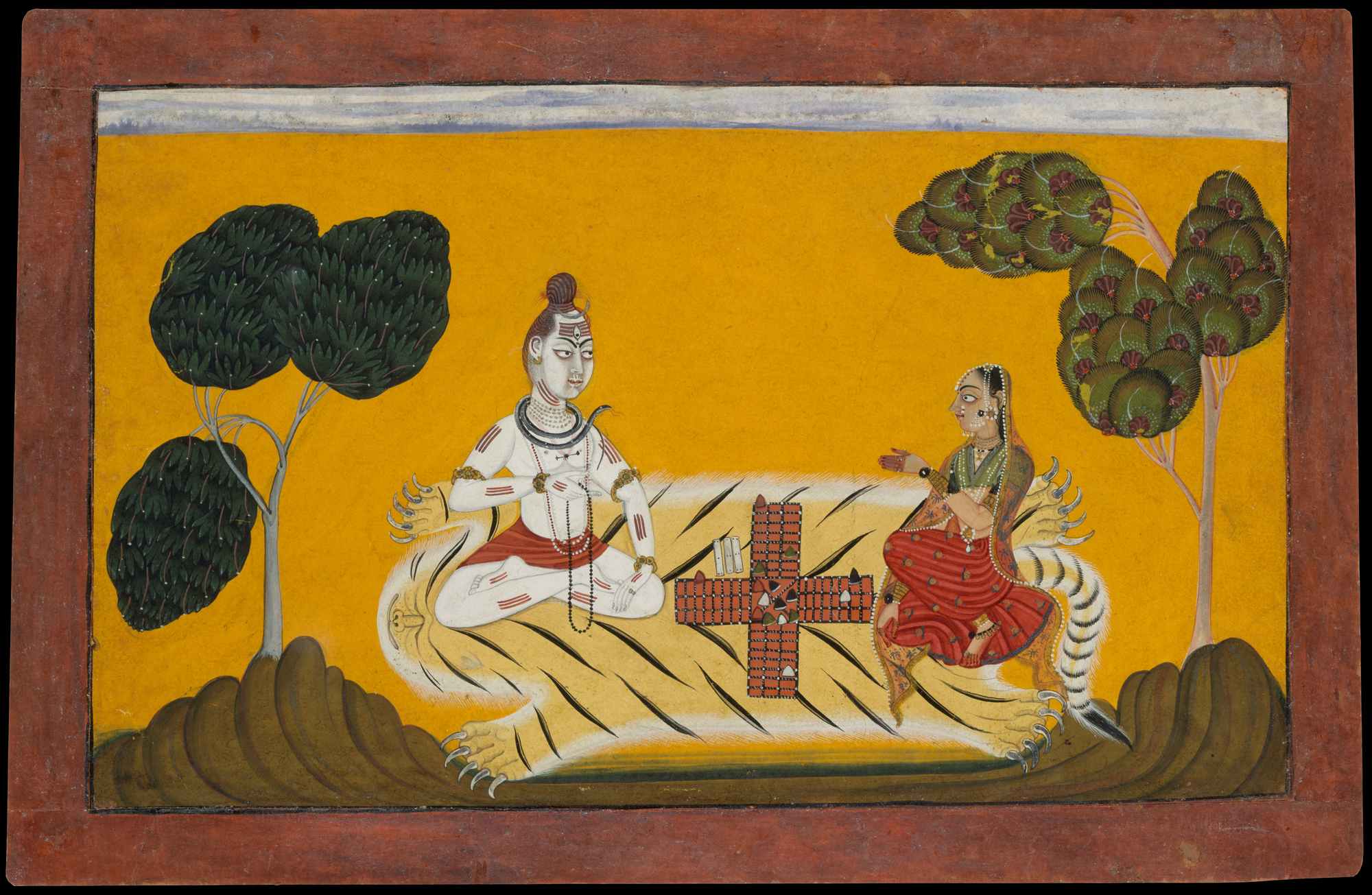

History
Chauparh is a very ancient game. There is reference to it being played in theThe game
Chauparh is also called Chaupat and Sara Passa ( pa, ਸਾਰਾ ਪਾਸਾ). The game involves concentration and is played with 4 players. If there are more players, then teams of 4 are formed with each team have 2 players on each side. The game is played on the floor using the following: * 7 Kaudian ( pa, ਕੌਡੀਆਂ). A Kaudi is a shell. * Each player is to have 4 pieces of coloured cloth called gotta ( pa, ਗੋਟਾ); * A cloth called Chauparh. Chaupar is made of two cotton or woolen strips intersecting each at right angles making a cross with four segments. The pieces are moved on the board according to throw of the Kaudian with the aim to enter ‘home’ on the Chauparh. If this is not available, then the boxes are drawn on the floor. One player throws the Kaudian into the air with the aim of obtaining a "Pa-oo" ( pa, ਪਾਉ), which is achieved as follows: * 6 Kaudian are upright and one lands face down; * 6 Kaudian are downright and one is upright; or * 5 Kaudian are upright and 2 land facing down. The gotta (coloured cloth) is moved as follows: * If 6 Kaudian are upright and one lands face down then eleven moves are gained on the Chauparh. * If 5 Kaudian are upright and 2 land facing down then 2 moves on the Chauparh. * If 3 Kaudian are upright and 4 land face down then 3 moves are gained. * If 4 Kaudian are upright and 3 downright then 4 moves are gained * If 5 Kaudian are upright and 2 land downright then 25 moves are gained. (This is also called Athh (8)). * If 6 Kaudian are upright and 1 lands downright then 35 moves are gained. (This is also called pentar). * If 7 Kaudian are upright then 14 moves are gained. * If 7 Kaudan land upright then 7 moves are gained. In order to move the coloured gotta on the Chauparh, a pa-oo is necessary. If a player has 1 pa-oo, then he can move 1 gotta on the Chauparh. If he has 2 pa-oo, then 2 boxes. The aim is to "kill" the opponents gotta which is done by the opponent scoring the same points as represented by the gotta. A gotta cannot be "killed" if it is on the square with a spinning wheel.Khadda OR Gaji Chara ( pa, ਖੱਡਾ)
Borha khu ( pa, ਬੋੜਾ ਖੂਹ)
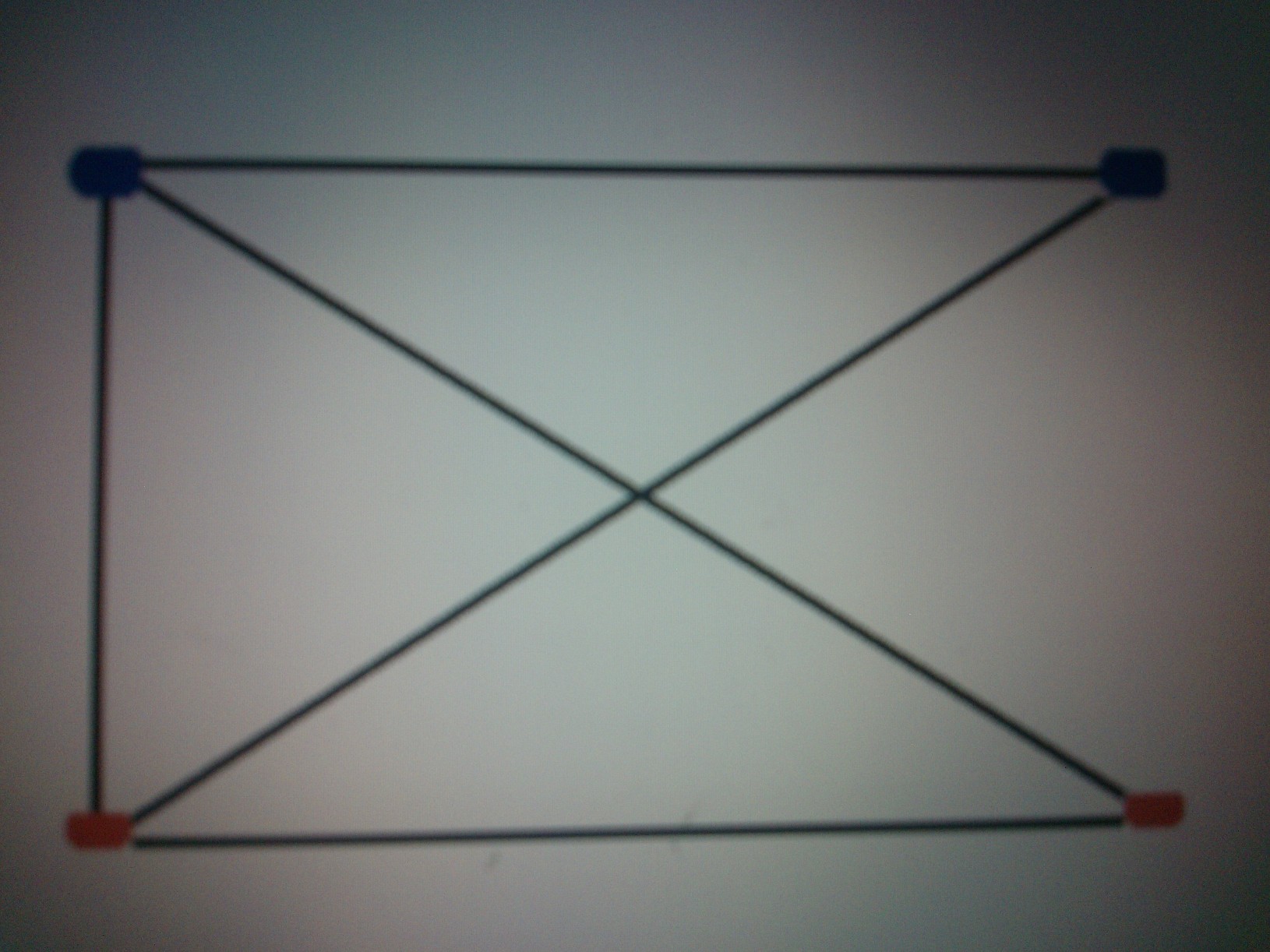
How to play
* Borha khu is played by two players. * Player 1 will use stones. * Player 2 will use small wood pieces. * Player 1 will place the stones on points 1 and 2. * Player 2 will place the wood pieces on points 3 and 4. * The middle point will be left empty. * The aim is to move along the lines and kill the opponent's piece.See also
*Indian Association of Traditional Sports and Games
Arunachal Olympic Association president Padi Richo was unanimously elected as the president and Aman Kumar Sharma (of Punjab) as secretary-generalIndian Association of Traditional Sports and Games (IATSG) to revive and promote traditional games and sports under the guidance of the International Council for Traditional Sports and Games (ICTSG
Ref
.
References
External links
* Amateur Circle Kabaddi Federation of IndiHugeDomains.com - KabaddiCircle.com is for sale (Kabaddi Circle)
* Pictures of traditional Punjabi game
{{Punjab, India
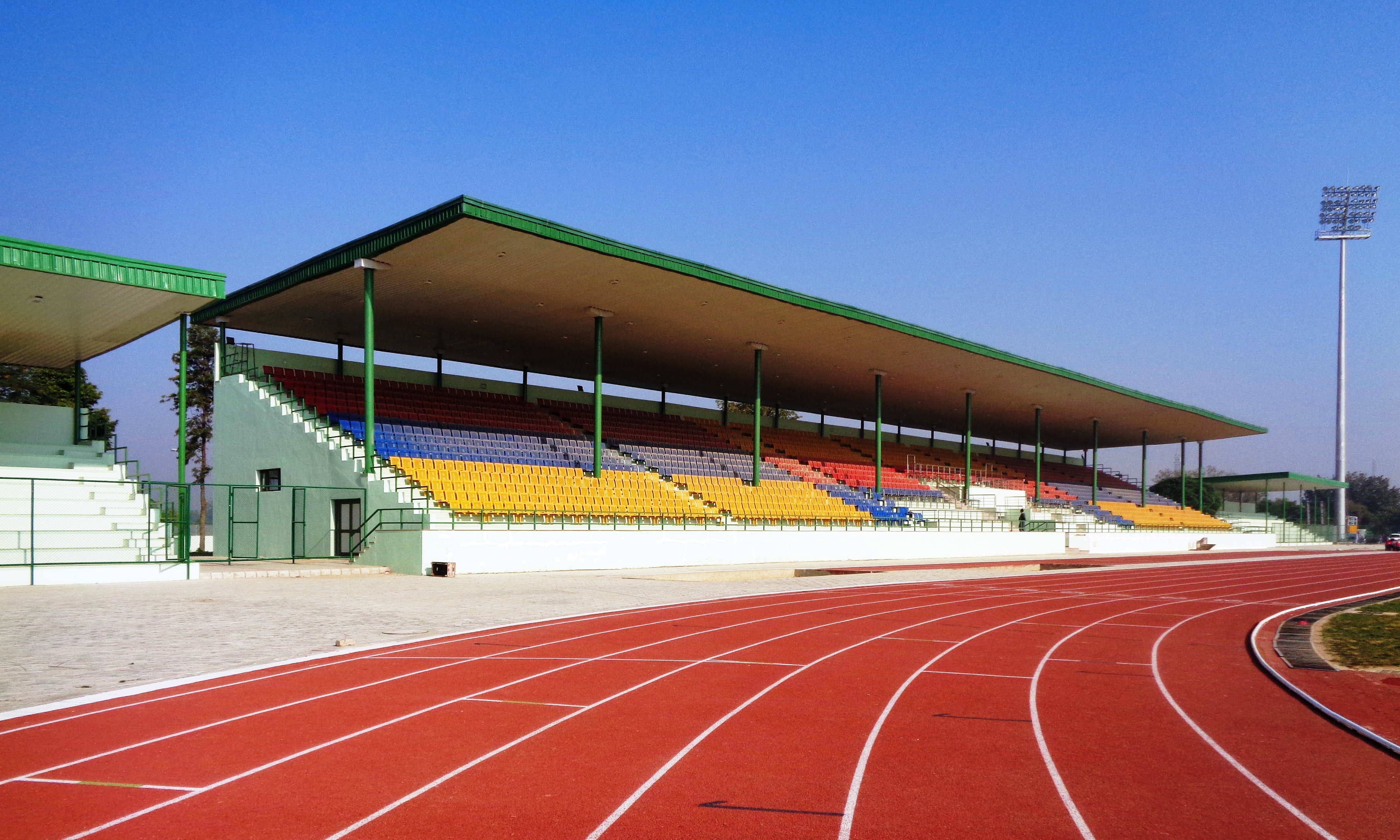

International Council for Traditional Sports and Games (ICTSG)
Sport in Punjab, India Traditional sports of India